Harris C.M., Piersol A.G. Harris Shock and vibration handbook
Подождите немного. Документ загружается.

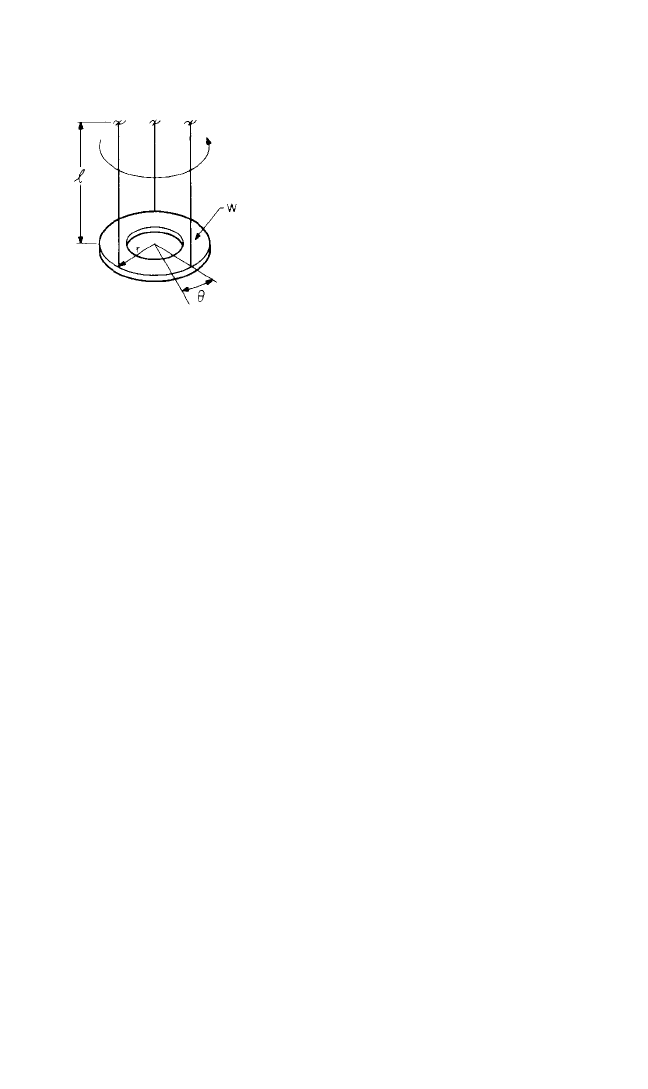
EXPERIMENTAL DETERMINATION OF POLAR MOMENT OF INERTIA
For complex shaft elements such as couplings or small flywheels, it is often easier to
determine the polar moment of inertia
experimentally than to calculate it. In
one experimental technique the element
is suspended from three equally spaced
vertical wires as shown in Fig. 38.6. The
element whose polar moment of inertia
is to be measured is hung on the cables
and set into torsional motion. Then the
period of vibration is measured. The
experimentally determined period of
torsional vibration, the weight of the
element, the length of the suspending
cables, and the radius of attachment of
the cables are used to determine the
polar moment of inertia from the fol-
lowing formula:
J = lb-in.sec
2
(38.5)
where J = polar moment of inertia
τ = period of vibration, sec/cycle
W = weight of element, lb
l = length of cables, in.
r = radius of suspending cables, in.
CALCULATION OF STIFFNESS
Shaft. The stiffness of a circular shaft is the most common elastic element encoun-
tered in the modeling process. Table 38.1 shows some common formulas used to cal-
culate torsional stiffness of a hollow circular shaft, a tapered circular shaft, and two
geared shafts.The stiffness is referred to the rotational speed of shaft No. 1.The iner-
tia of geared shafts is obtained in a similar manner.
Crankshaft. The crankshaft stiffness is the most uncertain element in a torsional
vibration calculation. Shaft stiffness can be measured experimentally either by twist-
ing a shaft with a known torque or from the observed values of the critical speeds in
a running engine. Alternatively, it can be calculated from semiempirical formulas
such as those given in Ref. 1. Those given by Eqs. (38.6), (38.7), and (38.8) are rec-
ommended. Refer to Fig. 38.7 for definitions of the dimensions; l
e
is the length of a
solid shaft of diameter D
s
equal in torsional stiffness to the section of crankshaft
between crank centers.
Wilson’s formula
2
=+ + (38.6)
r − 0.2(D
s
+ D
c
)
hW
3
a + 0.4D
c
D
c
4
− d
c
4
b + 0.4d
s
D
s
4
− d
s
4
l
e
D
s
4
Wr
2
2
(6.28)
2
l
TORSIONAL VIBRATION IN RECIPROCATING AND ROTATING MACHINES 38.5
FIGURE 38.6 Experimental determination of
the polar moment of inertia. An element of
weight W is suspended by three wires and the
period of the torsional motion is determined.
8434_Harris_38_b.qxd 09/20/2001 12:26 PM Page 38.5
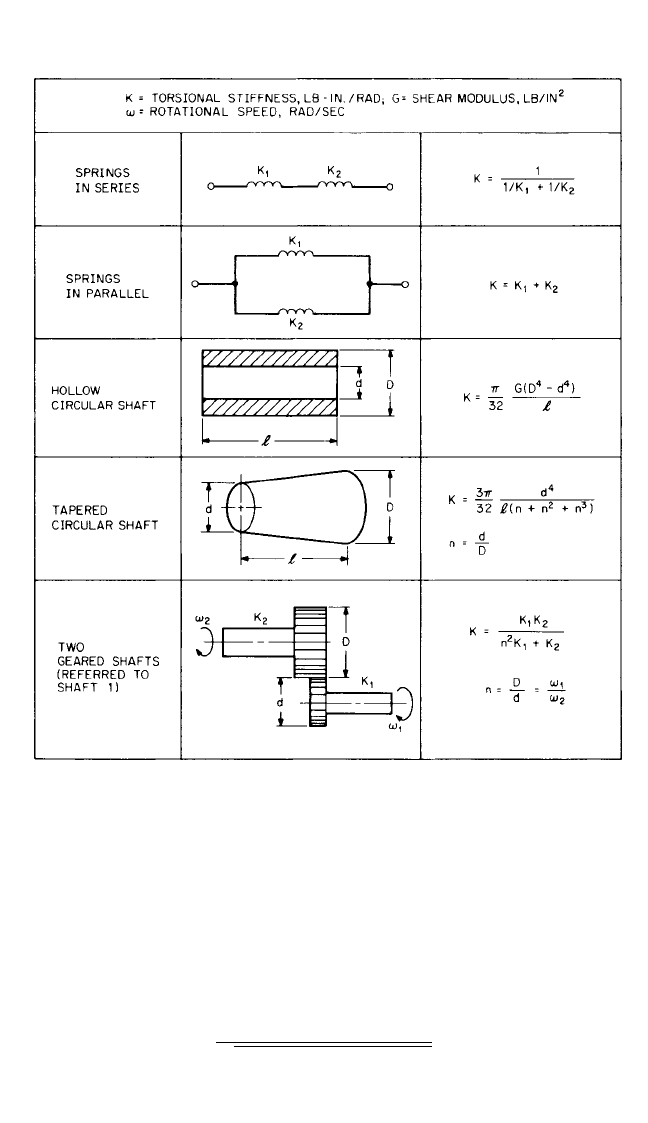
Ziamanenko’s formula
=+ + (38.7)
Constant’s formula
=
++
(38.8)
where α
1
, α
2
, α
3
, and α
4
are modifying factors, determined as follows:
α
1
= 1 −
0.0825
+−0.32
(38.9)
W
c
− d
c
2W
c
W
s
− d
s
2W
s
0.94
hW
3
a
D
c
4
− d
c
4
b
D
s
4
− d
s
4
1
α
1
α
2
α
3
α
4
l
e
D
s
4
r
3/2
hW
3
D
c
1/2
0.8a + 0.2(W/r)D
s
D
c
4
− d
c
4
b + 0.6hD
s
/b
D
s
4
− d
s
4
l
e
D
s
4
38.6 CHAPTER THIRTY-EIGHT
TABLE 38.1 Formulas for Torsional Stiffness
8434_Harris_38_b.qxd 09/20/2001 12:26 PM Page 38.6
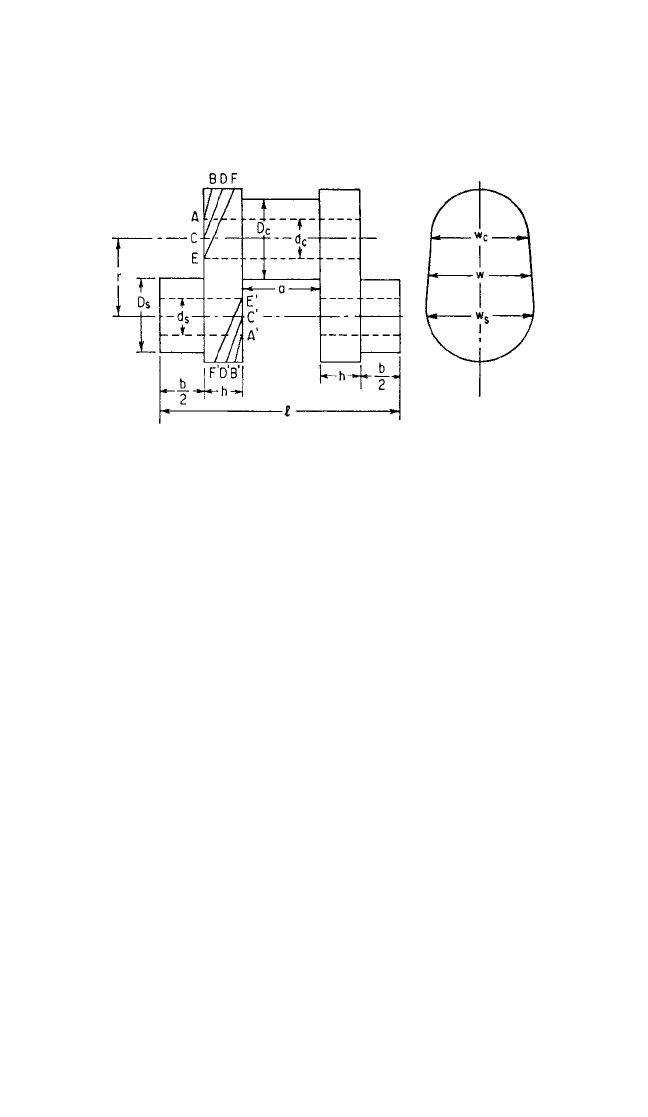
If the shaft is solid, assume α
1
= 0.9. The factor α
2
is a web-thickness modification
determined as follows: If 4h/l is greater than
2
⁄3, then α
2
= 1.666 − 4h/l. If 4h/l <
2
⁄3,
assume α
2
= 1.The factor α
3
is a modification for web chamfering determined as fol-
lows: If the webs are chamfered, estimate α
3
by comparison with the cuts on Fig. 38.7:
Cut AB and A′B′, α
3
= 1.000; cut CD alone, α
3
= 0.965; cut CD and C′D′, α
3
= 0.930;
cut EF alone, α
3
= 0.950; cut EF and E′F ′, α
3
= 0.900; if ends are square, α
3
= 1.010.
The factor α
4
is a modification for bearing support given by
α
4
=+B (38.10)
For marine engine and large stationary engine shafts: A = 0.0029, B = 0.91
For auto and aircraft engine shafts: A = 0.0100, B = 0.84
If α
4
as given by Eq. (38.10) is less than 1.0, assume a value of 1.0.
The Constant’s formula, Eq. (38.8), is recommended for shafts with large bores
and heavy chamfers.
Changes in Section. The shafting of an engine system may contain elements such
as changes of section, collars, shrunk and keyed armatures, etc., which require the
exercise of judgment in the assessment of stiffness. For a change of section having a
fillet radius equal to 10 percent of the smaller diameter, the stiffness can be esti-
mated by assuming that the smaller shaft is lengthened and the larger shaft is short-
ened by a length λ obtained from the curve of Fig. 38.8. This also may be applied to
flanges where D is the bolt diameter.The stiffening effect of collars can be ignored.
Shrunk and Keyed Parts. The stiffness of shrunk and keyed parts is difficult to
estimate as the stiffening effect depends to a large extent on the tightness of the
shrunk fit and keying. The most reliable values of stiffness are obtained by neglect-
ing the stiffening effect of an armature and assuming that the armature acts as a con-
centrated mass at the center of the shrunk or keyed fit. Some armature spiders and
flywheels have considerable flexibility in their arms; the treatment of these is dis-
cussed in the section Geared and Branched Systems.
Elastic Couplings. Properties of numerous types of torsionally elastic couplings
are available from the manufacturers and are given in Ref. 1.
Al
3
w
D
c
4
− d
c
4
TORSIONAL VIBRATION IN RECIPROCATING AND ROTATING MACHINES 38.7
FIGURE 38.7 Schematic diagram of one crank of a crankshaft.
8434_Harris_38_b.qxd 09/20/2001 12:26 PM Page 38.7
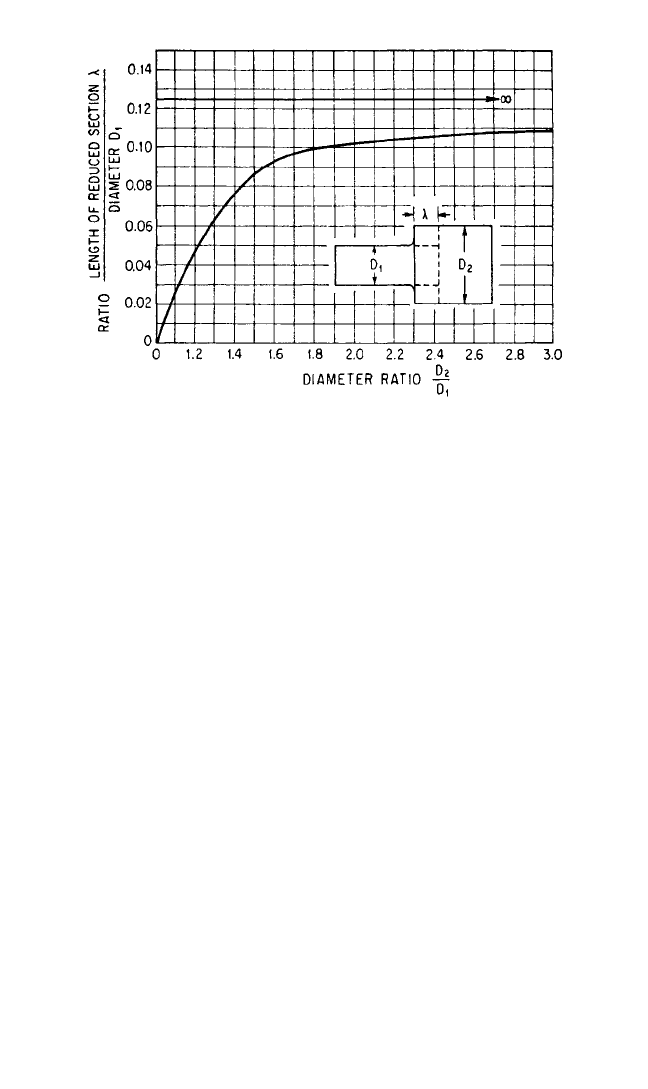
GEARED AND BRANCHED SYSTEMS
The natural frequencies of a system containing gears can be calculated by assuming
a system in which the speed of the driver unit is n times the speed of the driven
equipment. Multiply all the inertia and elastic constants on the driven side of the sys-
tem by 1/n
2
, and calculate the system’s natural frequencies as if no gears exist. In any
calculations involving damping constants on the driven side, these constants also are
multiplied by 1/n
2
. Torques and deflections thus obtained on the driven side of this
substitute system, when multiplied by n and 1/n, respectively, are equal to those in
the actual geared system.Alternatively, the driven side can be used as the reference;
multiply the driver constants by n
2
.
Where two or more drivers are geared to a common load, hydraulic or electrical
couplings may be placed between the driver and the gears. These serve as discon-
nected clutches; they also insulate the gears from any driver-produced vibration.
This insulation is so perfect that the driver end of the system can be calculated as if
terminating at the coupling gap. The damping effect of such couplings upon the
vibration in the driver end of the system normally is quite small and should be dis-
regarded in amplitude calculations.
The majority of applications without hydraulic or electrical couplings involve two
identical drivers. For such systems the modes of vibration are of two types:
1. The opposite-phase modes in which the drivers vibrate against each other with
a node at the gear.These are calculated for a single branch in the usual manner, ter-
minating the calculation at the gear. The condition for a natural frequency is that
β=0 at the gear.
2. The like-phase modes in which the two drivers vibrate in the same direction
against the driven machinery.To calculate these frequencies, the inertia and stiffness
constants of the driver side of one branch are doubled; then the calculation is made
38.8 CHAPTER THIRTY-EIGHT
FIGURE 38.8 Curve showing the decrease in stiffness resulting from a
change in shaft diameter.The stiffness of the shaft combination is the same
as if the shaft having diameter D
1
is lengthened by λ and the shaft having
diameter D
2
is shortened by λ.(F. Porter.
3
)
8434_Harris_38_b.qxd 09/20/2001 12:26 PM Page 38.8

as if there were only a single driver. The condition for a natural frequency is zero
residual torque at the end.
If the two identical drivers rotating in the same direction are so phased that the
same cranks are vertical simultaneously, all orders of the opposite-phase modes will
be eliminated. The two drivers can be so phased as to eliminate certain of the like-
phase modes. For example, if the No. 1 cranks in the two branches are placed at an
angle of 45° with respect to each other, the fourth, twelfth, twentieth, etc., orders, but
no others, will be eliminated. If the drivers are connected with clutches, these phas-
ing possibilities cannot be utilized.
In the general case of nonidentical branches the calculation is made as follows:
Reduce the system to a 1:1 gear ratio. Call the branches a and b. Make the sequence
calculation for a branch, with initial amplitude β=1, and for the b branch, with the
initial amplitude the algebraic unknown x. At the junction equate the amplitudes
and find x. With this numerical value of the amplitude x substituted, the torques in
the two branches and the torque of the gear are added; then the sequence calcula-
tion is continued through the last mass.
The branch may consist of a single member elastically connected to the system.
Examples of such a branch are a flywheel with appreciable flexibility in its spokes or
an armature with flexibility in the spider. Let I be the moment of inertia of the fly-
wheel rim and k the elastic constant of the connection. Then the flexibly mounted
flywheel is equivalent to a rigid flywheel of moment of inertia
I′= (38.11)
NATURAL FREQUENCY CALCULATIONS
If the model of a system can be reduced to two lumped masses at opposite ends of a
massless shaft, the natural frequency is given by
f
n
=
Hz (38.12)
The mode shape is given by θ
2
/θ
1
=−J
1
/J
2
.
For the three-mass system shown in Fig. 38.9, the natural frequencies are
f
n
=
A
±
(
A
2
−
B
)
1
/2
Hz (38.13)
where A =+
B =
In Eqs. (38.12) and (38.13) the ks are torsional stiffness constants expressed in
lb-in./rad. The notation k
12
indicates that the constant applies to the shaft between
rotors 1 and 2. The polar inertia J has units of lb-in.-sec
2
.
(J
1
+ J
2
+ J
3
)k
12
k
23
J
1
J
2
J
3
k
23
(J
1
+ J
2
)
2J
1
J
2
k
12
(J
1
+ J
2
)
2J
1
J
2
1
2π
(J
1
+ J
2
)k
J
1
J
2
1
2π
I
1 − Iω
2
/k
TORSIONAL VIBRATION IN RECIPROCATING AND ROTATING MACHINES 38.9
8434_Harris_38_b.qxd 09/20/2001 12:26 PM Page 38.9
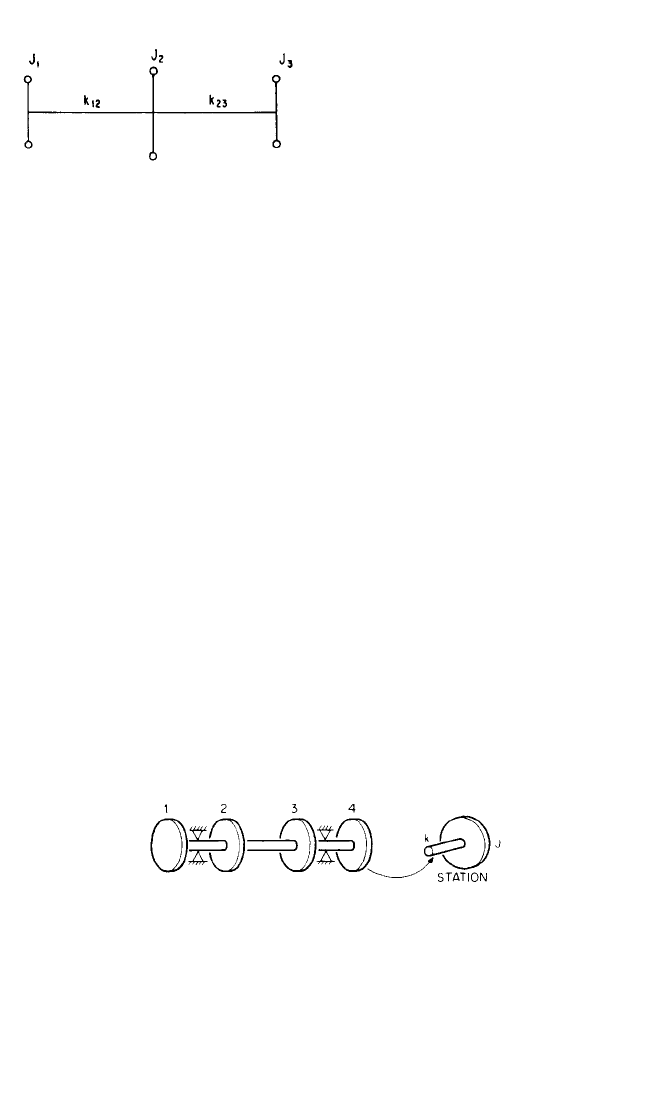
The above formulas and all the
developments for multimass torsional
systems that follow also apply to sys-
tems with longitudinal motion if the
polar moments of inertia J are replaced
by the masses m = W/g and the torsional
stiffnesses are replaced by longitudinal
stiffnesses.
TRANSFER MATRIX METHOD
The transfer matrix method
4
is an extended and generalized version of the Holzer
method. Matrix algebra is used rather than a numerical table for the analysis of tor-
sional vibration problems. The transfer matrix method is used to calculate the natu-
ral frequencies and critical speeds of other eigenvalue problems.
The transfer matrix and matrix iteration (Stodola) methods are numerical proce-
dures. The fundamental difference between them lies in the assumed independent
variable. In any eigenvalue problem, a unique mode shape of the system is associ-
ated with each natural frequency. The mode shape is the independent variable used
in the matrix iteration method. A mode shape is assumed and improved by succes-
sive iterations until the desired accuracy is obtained; its associated natural frequency
is then calculated.
A frequency is assumed in the transfer matrix method, and the mode shape of
the system is calculated. If the mode shape fits the boundary conditions, the
assumed frequency is a natural frequency and a critical speed is derived. Determin-
ing the correct natural frequencies amounts to a controlled trial-and-error process.
Some of the essential boundary conditions (geometrical) and natural boundary
conditions (force) are assumed, and the remaining boundary condition is plotted vs.
frequency to obtain the natural frequency; the procedure is similar to the Holzer
method. For example, if the torsional system shown in Fig. 38.10 were analyzed, the
natural boundary conditions would be zero torque at both ends. The torque at sta-
tion No. 1 is made zero, and the torsional vibration is set at unity.Then M
4
as a func-
tion of ω is plotted to find the natural frequencies. This plot is obtained by utilizing
the system transfer functions or matrices. These quantities reflect the dynamic
behavior of the system.
38.10 CHAPTER THIRTY-EIGHT
FIGURE 38.9 Schematic diagram of a shaft
represented by three masses.
FIGURE 38.10 Typical torsional vibration model.
No accuracy is lost with the transfer matrix method because of coupling of mode
shapes.Accuracy is lost with the matrix iteration method, however, because each fre-
quency calculation is independent of the others. A minor disadvantage of the trans-
fer matrix method is the large number of points that must be calculated to obtain an
M
4
vs ω curve. This problem is overcome if a high-speed digital computer is used.
A typical station (No. 4) from a torsional model is shown in Fig. 38.10. This gen-
eral station and the following transfer matrix equation, Eq. (38.14), are used in a way
8434_Harris_38_b.qxd 09/20/2001 12:26 PM Page 38.10
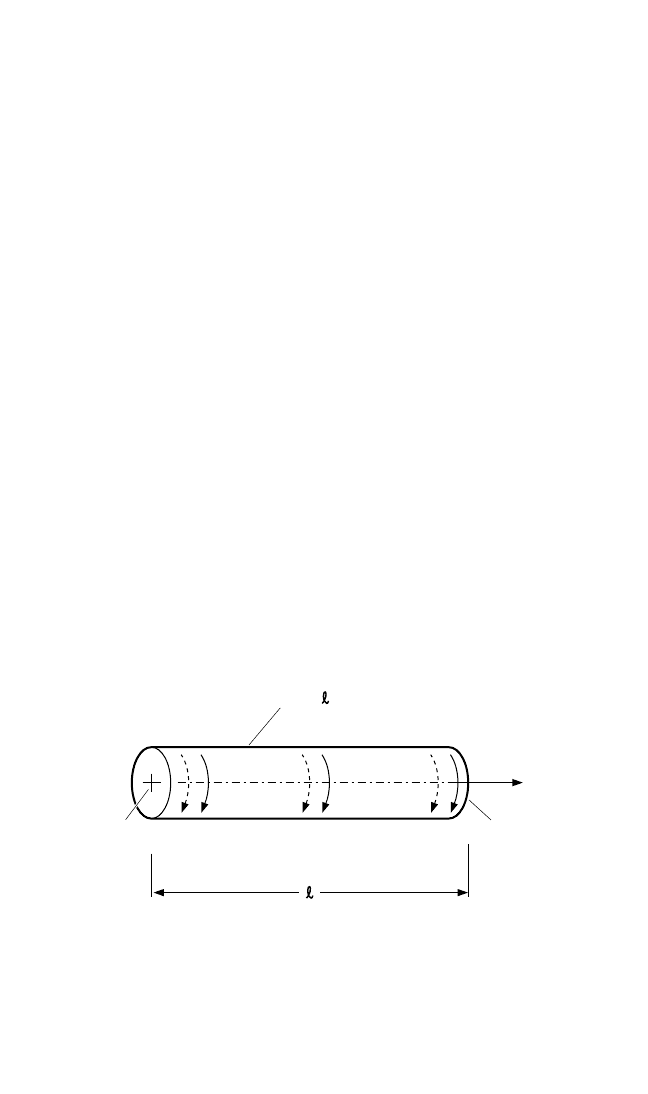
similar to the Holzer table to transfer the effects of a given frequency ω across the
model.
n
=
n
n − 1
(38.14)
where θ=torsional motion, rad
M = torque, lb-in.
ω=assumed frequency, rad/sec
J = station inertia, lb-in.-sec
2
k = station torsional stiffness, lb-in./rad
The stiffness and polar moment of inertia of each station are entered into the equa-
tion to determine the transfer effect of each element of the model.Thus, the calcula-
tion begins with station No. 1, which relates to the first spring and inertia in the
model of Fig. 38.10. The equation gives the output torque M
1
and output motion θ
1
for given input values, usually 0 and 1, respectively. The equation is used on station
No. 2 to obtain M
2
output and θ
2
output as a function of M
1
output and θ
1
output.
This process is repeated to find the value of M and θ at the end of the model. This
calculation is particularly suited for the digital computer with spreadsheet programs.
FINITE ELEMENT METHOD
The finite element method is a numerical procedure (described in Chap. 28, Part II)
to calculate the natural frequencies, mode shapes, and forced response of a dis-
cretely modeled structural or rotor system. The complex rotor system is composed
of an assemblage of discrete smaller finite elements which are continuous structural
members. The displacements (angular) are forced to be compatible, and force
(torque) balance is required at the joints (often called nodes).
θ
M
1/k
−(ω
2
J/k) + 1
1
−ω
2
J
θ
M
TORSIONAL VIBRATION IN RECIPROCATING AND ROTATING MACHINES 38.11
θ(t)
θ
1
(t) M
1
(t) θ
2
(t)M(t)
JOINT 1 JOINT 2
ρ, I, G, A,
M
2
(t)
FIGURE 38.11 Finite element for torsional vibration in local
coordinates.
Figure 38.11 shows a uniform torsional element in local coordinates. The x axis is
taken along the centroidal axis. The physical properties of the element are density
(ρ), area (A), shear modulus of elasticity (G), length (l), and polar area moment (I).
M(t) are the torsional forcing functions.
8434_Harris_38_b.qxd 09/20/2001 12:26 PM Page 38.11

The torsional displacement within the element can be expressed in terms of the
joint rotations
1
(t) and
2
(t) as
(x,t) = U
1
(x)
1
(t) + U
2
(x)
2
(t) (38.15)
where U
1
(x) and U
2
(x) are called shape functions. Since (0,t) =
1
(t) and (l,t) =
2
(t), the shape functions must satisfy the boundary conditions:
U
1
(0) = 1 U
1
(l) = 0
U
2
(0) = 0 U
2
(l) = 1
The shape function for the torsional element is assumed to be a polynomial with
two constants of the form
U
i
(x) = a
i
+ b
i
x where i = 1,2 (38.16)
Selection of the shape function is performed by the analyst and is a part of the engi-
neering art required to conduct accurate finite element modeling.
Thus with four known boundary conditions the values of a
i
and b
i
can be deter-
mined from Eq. (38.16):
U
1
(x) = 1 − U
2
(x) =
Then from Eq. (38.15)
(x,t) =
1 −
1
(t) +
2
(t)
The kinetic energy, strain energy, and virtual work are used to formulate the finite
element mass and stiffness matrices and the force vectors, respectively. These quan-
tities are used to form the equations of motion.These matrices, derived in Ref. 4, are
{J} =
{K} =
M =
M
1
(t)
=
l
0
M(x,t)
1 −
dx
M
2
(t)
l
0
M(x,t)
dx
where {J} = mass matrix
{K} = stiffness matrix
M = torque vector
ρ=density
I = area polar moment
G = shear modulus
l = length of element
x
l
x
l
−1
1
1
−1
GI
l
1
2
2
1
ρIl
6
x
l
x
l
x
l
x
l
38.12 CHAPTER THIRTY-EIGHT
8434_Harris_38_b.qxd 09/20/2001 12:26 PM Page 38.12
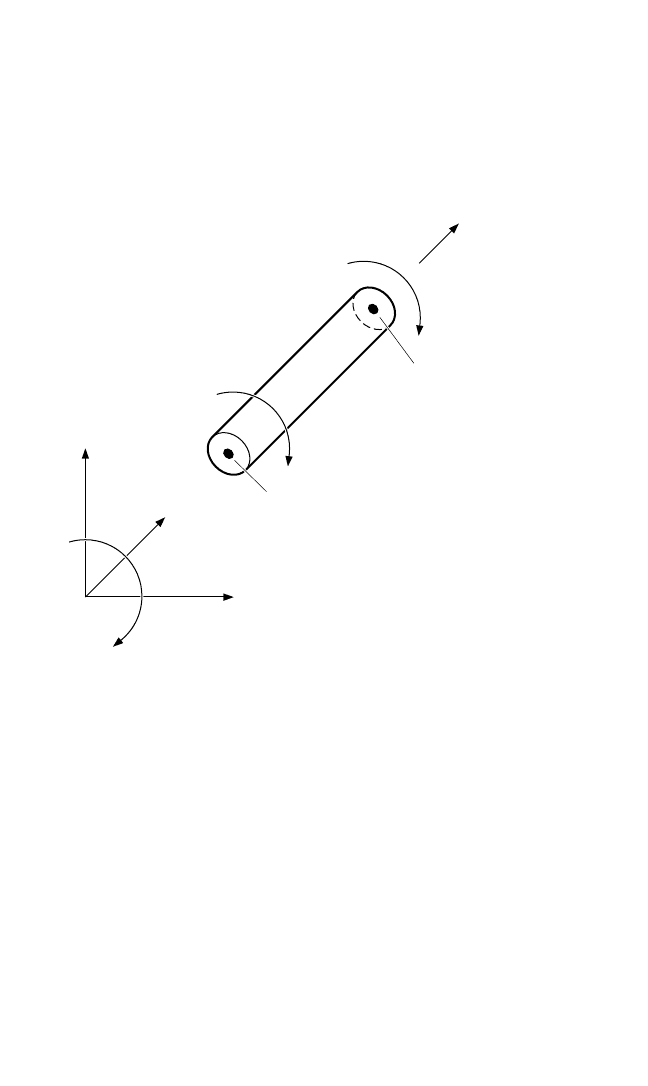
As noted, the previously described finite elements are in local coordinates. Since
the system as a whole must be analyzed as a unit, the elements must be transformed
into one global coordinate system. Figure 38.12 shows the local element within a
global coordinate system. The mass and stiffness matrices and joint force vector of
each element must be expressed in the global coordinate system to find the vibration
response of the complete system.
TORSIONAL VIBRATION IN RECIPROCATING AND ROTATING MACHINES 38.13
Using transformation matrices,
4
the mass and stiffness matrices and force vectors
are used to set up the system equation of motion for a single element in the global
coordinates:
[J]
e
{
¨
Θ(t)} + [K]
e
{
¨
Θ(t)} = {M
e
(t)}
The complete system is an assemblage of the number of finite elements it
requires to adequately model its dynamic behavior. The joint displacements of the
elements in the global coordinate system are labeled as Θ
1
(t), Θ
2
(t),...,Θ
m
(t), or
this can be expressed as a column vector:
Θ
1
(t)
Θ
2
(t)
{Θ(t)} =
⋅
⋅
⋅
Θ
m
(t)
X
GLOBAL
AXIS
Y
Z
i
j
e
Θ
i
(t)
Θ
j
(t)
x (LOCAL AXIS)
Θ
FIGURE 38.12 Local and global joint displacements of element, l.
8434_Harris_38_b.qxd 09/20/2001 12:26 PM Page 38.13

Using global joint displacements, mass and stiffness matrices, and force vectors,
the equations of motion are developed:
[J]
nxn
{
¨
Θ}
nx1
+ [K]
nxn
{Θ}
nx1
= {M}
nx1
where n denotes the number of joint displacements in the system.
In the final step prior to solution, appropriate boundary conditions and con-
straints are introduced into the global model.
The equations of motion for free vibration are solved for the eigenvalues (natu-
ral frequencies) using the matrix iteration method (Chap. 28, Part I). Modal analysis
is used to solve the forced torsional response. The finite element method is available
in commercially available computer programs for the personal computer. The ana-
lyst must select the joints (nodes, materials, shape functions, geometry, torques, and
constraints) to model the system for computation of natural frequencies, mode
shapes, and torsional response. Similar to other modeling efforts, engineering art and
a knowledge of the capabilities of the computer program enable the engineer to
provide reasonably accurate results.
CRITICAL SPEEDS
The crankshaft of a reciprocating engine or the rotors of a turbine or motor, and all
moving parts driven by them, comprise a torsional elastic system. Such a system has
several modes of free torsional oscillation. Each mode is characterized by a natural
frequency and by a pattern of relative amplitudes of parts of the system when it is
oscillating at its natural frequency. The harmonic components of the driving torque
excite vibration of the system in its modes. If the frequency of any harmonic compo-
nent of the torque is equal to (or close to) the frequency of any mode of vibration, a
condition of resonance exists and the machine is said to be running at a critical
speed. Operation of the system at such critical speeds can be very dangerous, result-
ing in fracture of the shafting.
The number of complete oscillations of the elastic system per unit revolution of
the shaft is called an order of the operating speed. It is an order of a critical speed if
the forcing frequency is equal to a natural frequency. An order of a critical speed
that corresponds to a harmonic component of the torque from the engine as a whole
is called a major order. A critical speed also can be excited that corresponds to the
harmonic component of the torque curve of a single cylinder. The fundamental
period of the torque from a single cylinder in a four-cycle engine is 720°; the critical
speeds in such an engine can be of
1
⁄2,1,1
1
⁄2,2,2
1
⁄2, etc., order. In a two-cycle engine
only the critical speeds of 1, 2, 3, etc., order can exist. All critical speeds except those
of the major orders are called minor critical speeds; this term does not necessarily
mean that they are unimportant. Therefore the critical speeds occur at
rpm (38.17)
where f
n
is the natural frequency of one of the modes in Hz, and q is the order num-
ber of the critical speed. Although many critical speeds exist in the operating range
of an engine, only a few are likely to be important.
A dynamic analysis of an engine involves several steps. Natural frequencies of the
modes likely to be important must be calculated.The calculation is usually limited to
the lowest mode or the two lowest modes. In complicated arrangements, the calcula-
tion of additional modes may be required, depending on the frequency of the forces
60f
n
q
38.14 CHAPTER THIRTY-EIGHT
8434_Harris_38_b.qxd 09/20/2001 12:26 PM Page 38.14
